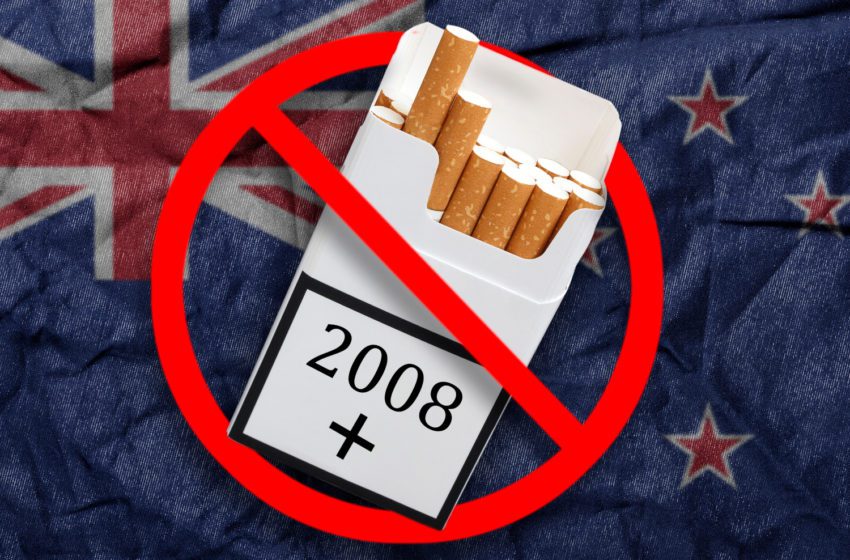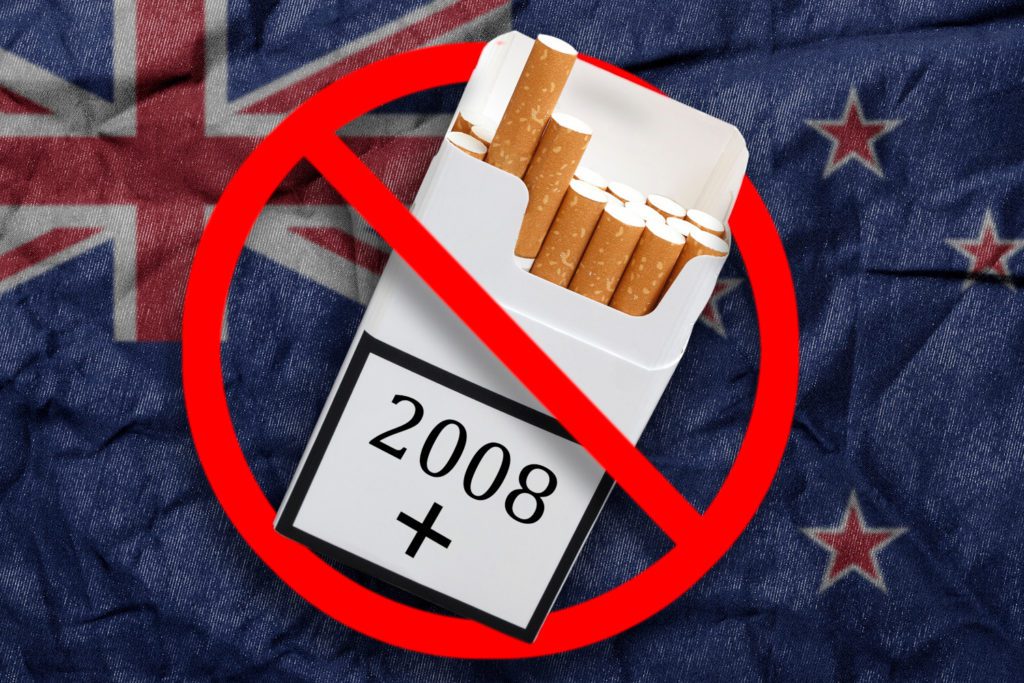Banned for Life
- Print Edition
- October 3, 2022
- 0
- 11 minutes read

Photo: Nikolay

Harm reduction activists worry about New Zealand’s plan to phase out tobacco use.
By Stefanie Rossel
Imagine it’s 2039. You’re at one of a few remaining tobacconist stores with a former classmate, both trying to buy some combustible cigarettes. But as it happens, you were born on New Year’s Day 2009 and your friend on New Year’s Eve 2008. An ID check lets him acquire the desired smokes, but you are not allowed to buy the products—for the duration of your life.
This is a situation New Zealanders will soon be facing. In January, New Zealand unveiled its Smoke-Free Aotearoa 2025 Action Plan, an amendment of the country’s Smokefree Environments Act (1990), which seeks to take the country’s already low current smoking prevalence of just under 10 percent down to 5 percent or below within the next three years.
The proposal’s most spectacular element is a generational tobacco ban: Starting in 2023, anyone born on or after Jan. 1, 2009, would be barred for life from purchasing combustible cigarettes under the new rules. Someone aged 14 when the law entered into effect would hence never be able to legally purchase tobacco. In a statement, Ayesha Verrall, the country’s associate health minister, said the government wants to make sure young people never start smoking. While it would still take decades to phase out tobacco products completely, the generation currently at school would feel the effect of the legislation very soon.
In late July, the bill passed the first reading in Parliament. It is now being reviewed by the Parliament’s public health select committee and is expected to be adopted in December. The regulation would be a world first, and implementation is likely; Prime Minister Jacinda Ardern’s Labour Party is governing with an absolute majority.

Reactions to the proposal have been divided, according to Nancy Loucas, co-founder of Aotearoa Vapers Community Advocacy (AVCA). The association agrees with the “smoke-free generation” in principle but remains concerned that it could be an overreach. “Our youth smoking rate is already at 1.3 percent, so many are saying it’s unnecessary and overkill,” she says. “There are concerns [that] an older sibling giving someone from the smoke-free generation [SFG] tobacco may be criminalized, and that is not acceptable. Others are saying it’s a possible human rights violation because if someone from the SFG comes of age and can drink, etc., but not buy tobacco, how can the government prevent a legal adult from a legal consumer product? The reaction has been much more negative than the government expected, I would say.”

Marewa Glover, director of the Centre of Research Excellence: Indigenous Sovereignty and Smoking, describes the strategy as “virtue signaling.” “The negative consequences of previous ‘smoke-free’ legislation are already resulting in an uptick in young people committing robberies for tobacco and being charged and imprisoned for such crimes,” she says. “Youth mental health and preventing youth suicide are a higher priority for increased intervention. The negative consequences of the proposed legislation risks will be worsening that crisis. The law will create an unnecessarily larger bureaucracy, increased enforcement activity, and more people will be diverted into the justice system. It also will set a dangerous precedent. Young people are not taking up smoking now. It is no longer considered ‘cool.’ The rationale for preventing the ‘rite of passage,’ as stated by the minister in her interview on June 21, 2022, with the editor of the Tobacco Control journal, is therefore outdated and flawed.”
The proposal not only discriminates against age. Legal experts have indicated that the generational ban will particularly target Maori and Pacific Islanders, among whom smoking prevalence is disproportionately high. According to Health New Zealand, the Maori smoking rate was 31.4 percent in 2019–2020. At 32 percent, Maori women constitute New Zealand’s highest smoking rate. According to critics, the generational tobacco ban could end up stigmatizing certain communities. “That is a very real possibility,” confirms Loucas. “The Maori and Pacifica communities are already disadvantaged, and the last thing they need is more stigma and discrimination.”
Glover, who has been working closely with Maori smokers for years, says New Zealand’s adoption of government Ministry of Health campaigns to encourage people who smoke to quit or switch to vaping is working particularly well for Maori. “There is no need for another drastic punitive law to be passed. The negative consequences already mentioned will worsen other outcomes for Maori, e.g., associated with the increase in black market activity.”
Rapid Withdrawal
Proponents say the goal of a smoke-free generation is achievable and realistic whereas smokers’ rights advocates consider the plan an attack on personal freedoms, a prohibition that will not work. Others fear it might backfire and fuel the already burgeoning illicit cigarette market, which is estimated to account for around 10 percent of New Zealand’s total tobacco market. Loucas believes the illicit market is much higher because the official numbers capture only imports while leaving out the growers and sellers in the country. “The gangs will take over as they have with everything else the government ‘bans’ if the law is punitive,” she says. “Bans don’t work. They never have and never will. The market, especially the gray and black market, will always rise to meet the need.”
The two other components of New Zealand’s Action Plan also have the potential to boost the black market: Starting in 2024, the number of legal retail outlets will be reduced from about 8,000 to fewer than 500. Cigarettes will no longer be available at kiosks, gas stations or supermarkets, with sales limited to licensed tobacco retailers. From 2025, the country will mandate the sale of very low-nicotine cigarettes. Currently, a 90 percent to 95 percent nicotine reduction to nonaddictive levels is being discussed. With a sense of understatement, Glover describes a nicotine yield of below 0.05 mg per gram as “subfunctional.”
Almost overnight, New Zealand’s government will make its citizens quit cold turkey. In contrast to the World Health Organization’s anti-tobacco harm reduction stance, though, the proposed law includes a massive broadening of addiction therapy offers. Vaping, which was regulated in 2020, will remain legal. “Vaping has worked so far in the last year to cut the number of people who smoke down drastically,” says Loucas. “I think we stay the course. What is missing is a public education campaign that was slated to start upon legalization but was sidetracked because of Covid. That education plan needs to be rolled out immediately to stop the disinformation campaign from a select few NGOs [nongovernmental organizations] who are anti-nicotine.”

Legal Issues
With its tobacco control plans, New Zealand enters uncharted territory. While the tobacco-free generation was first discussed in 2010, it was never implemented anywhere on a nationwide scale. Bhutan banned tobacco sales and cultivation in 2010, but the measure backfired, with smugglers taking the place of legal vendors. In 2021, the Himalayan kingdom lifted the sales ban.
Mandatory very low-nicotine cigarettes, an objective also pursued by the U.S. Food and Drug Administration, might run into legal challenges as well, as AVCA points out. Like the generational tobacco ban, such a measure might prove to violate human rights on the basis that adults have the right to make informed choices. Vaping advocates believe there’s insufficient longitudinal research to prove that very low-nicotine cigarettes help people quit smoking. Further, the move could also see New Zealanders heading to the black market or growing their own tobacco.
The question of whether the planned measures are proportional is justified. New Zealand has been a model student as far as the implementation of tobacco control measures is concerned. From the 1970s, the country has used the full range of tobacco control instruments, including smoke-free laws, advertising bans and standardized cigarette packaging. Due to high taxation, New Zealand cigarette prices are the second-highest in the world after Australia’s. A pack of 20 Marlboro cigarettes retails at around nzd37 ($22.69). Smoking rates have dropped drastically over the past decades. With those lighting up accounting for less than 10 percent of the population, the country has roughly 450,000 smokers left.
A Blueprint for Others?
The world is watching as New Zealand embarks on its smoke-free experiment. Shortly after New Zealand had revealed its Action Plan, Singapore’s health authorities started debating whether the city state should follow suit by gradually raising the smoking age until it covers the entire population. However, Singapore is unlikely to copy New Zealand’s embrace of vaping as an alternative to smoking, as vape products are banned in the city state. Singapore has been fiercely anti-tobacco since the 1980s, with measures having become progressively stricter over the years. The country’s smoking prevalence presently stands at 10 percent.
Also in January, Malaysia announced it would ban the use, possession and sale of cigarettes and vape products for those born after 2007. The bill proposes a fine for offenders and also empowers enforcement officers to open without a warrant any baggage or container for inspection. The draft law was met with resistance from several sides. The parliamentary select committee on health called for the plan to be postponed by three years, arguing that the period should be used to study the possible need to enact separate legislation for combustible and noncombustible tobacco products.
In Malaysia, too, there are concerns about black market sales. Critics fear a generational tobacco ban would further invigorate the country’s illicit cigarette market, which is proportionally already the largest in the world, accounting for about 60 percent of the country’s total tobacco market. In August, the bill was sent back to the parliamentary select committee for further scrutiny. The regulation may be further delayed or even abandoned as Malaysia’s Parliament is expected to be dissolved in late October after the tabling of the budget.
Outside the Asia-Pacific region, Denmark said it wanted to introduce New Zealand-style measures, including a generational ban that would prohibit anyone born in or after 2010 to buy tobacco products.
“Bans and prohibition do not work,” Loucas emphasizes. “They create more harm, and that is the last thing any public health promoter wants as their legacy. In countries that are willing to accept tobacco harm reduction on the basis of science and evidence, they can (and should) see similar decreases in smoking relative to population, such as New Zealand has. But it requires risk-proportionate regulations and effective and compassionate enforcement.”

